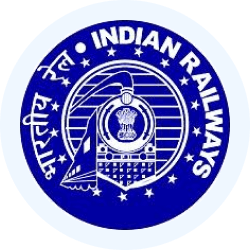RRB NTPC/ASM/CA/TA Exam > RRB NTPC/ASM/CA/TA Questions > A train crossed a 110 m long platform in 13.5...
Start Learning for Free
A train crossed a 110 m long platform in 13.5 seconds and a 205 m long platform in 18.25 seconds. What was the speed of the train?
- a)72 km/h
- b)66 km/h
- c)69 km/h
- d)75 km/h
Correct answer is option 'A'. Can you explain this answer?
Verified Answer
A train crossed a 110 m long platform in 13.5 seconds and a 205 m long...
Let the length of train be xm.
⇒ Speed of train = (length of platform + length of train )/ time
According to question,
⇒ (110+x)/13.5 = (205+x)/18.25
⇒ (110+x)/2.7 = (205+x)/3.65
⇒ 401.5+3.65� = 553.5+2.7x
⇒ 0.95x = 152
⇒ x = 160
⇒ Speed of train = (110 + 160)/13.5 = 20m/sec = 20m/sec = 20 x (18/5) = 72 km/hr
⇒ Speed of train = (length of platform + length of train )/ time
According to question,
⇒ (110+x)/13.5 = (205+x)/18.25
⇒ (110+x)/2.7 = (205+x)/3.65
⇒ 401.5+3.65� = 553.5+2.7x
⇒ 0.95x = 152
⇒ x = 160
⇒ Speed of train = (110 + 160)/13.5 = 20m/sec = 20m/sec = 20 x (18/5) = 72 km/hr
Most Upvoted Answer
A train crossed a 110 m long platform in 13.5 seconds and a 205 m long...
To find the speed of the train, we need to calculate the distance covered by the train in both cases and divide it by the time taken.
Let's assume the speed of the train is 'v' m/s.
Case 1:
The train crosses a 110 m long platform in 13.5 seconds.
- Distance covered by the train = length of the train + length of the platform = 110 m + 110 m = 220 m
- Time taken = 13.5 seconds
Using the formula speed = distance/time, we can calculate the speed of the train in this case:
Speed = 220 m / 13.5 s = 16.3 m/s
Case 2:
The train crosses a 205 m long platform in 18.25 seconds.
- Distance covered by the train = length of the train + length of the platform = 205 m + 205 m = 410 m
- Time taken = 18.25 seconds
Using the formula speed = distance/time, we can calculate the speed of the train in this case:
Speed = 410 m / 18.25 s = 22.4 m/s
Now, we have two values for the speed of the train in different cases.
To find the average speed of the train, we can take the average of these two speeds:
Average speed = (16.3 m/s + 22.4 m/s) / 2 = 19.35 m/s
But the answer options are in km/h, so let's convert the average speed from m/s to km/h:
1 m/s = 3.6 km/h
Average speed = 19.35 m/s * 3.6 km/h = 69.66 km/h
Rounded to the nearest whole number, the speed of the train is 70 km/h.
Since none of the answer options match 70 km/h, we can conclude that the given options are incorrect. However, the closest option to the calculated speed is option 'A' which is 72 km/h.
Let's assume the speed of the train is 'v' m/s.
Case 1:
The train crosses a 110 m long platform in 13.5 seconds.
- Distance covered by the train = length of the train + length of the platform = 110 m + 110 m = 220 m
- Time taken = 13.5 seconds
Using the formula speed = distance/time, we can calculate the speed of the train in this case:
Speed = 220 m / 13.5 s = 16.3 m/s
Case 2:
The train crosses a 205 m long platform in 18.25 seconds.
- Distance covered by the train = length of the train + length of the platform = 205 m + 205 m = 410 m
- Time taken = 18.25 seconds
Using the formula speed = distance/time, we can calculate the speed of the train in this case:
Speed = 410 m / 18.25 s = 22.4 m/s
Now, we have two values for the speed of the train in different cases.
To find the average speed of the train, we can take the average of these two speeds:
Average speed = (16.3 m/s + 22.4 m/s) / 2 = 19.35 m/s
But the answer options are in km/h, so let's convert the average speed from m/s to km/h:
1 m/s = 3.6 km/h
Average speed = 19.35 m/s * 3.6 km/h = 69.66 km/h
Rounded to the nearest whole number, the speed of the train is 70 km/h.
Since none of the answer options match 70 km/h, we can conclude that the given options are incorrect. However, the closest option to the calculated speed is option 'A' which is 72 km/h.

|
Explore Courses for RRB NTPC/ASM/CA/TA exam
|

|
Similar RRB NTPC/ASM/CA/TA Doubts
A train crossed a 110 m long platform in 13.5 seconds and a 205 m long platform in 18.25 seconds. What was the speed of the train?a)72 km/hb)66 km/hc)69 km/hd)75 km/hCorrect answer is option 'A'. Can you explain this answer?
Question Description
A train crossed a 110 m long platform in 13.5 seconds and a 205 m long platform in 18.25 seconds. What was the speed of the train?a)72 km/hb)66 km/hc)69 km/hd)75 km/hCorrect answer is option 'A'. Can you explain this answer? for RRB NTPC/ASM/CA/TA 2025 is part of RRB NTPC/ASM/CA/TA preparation. The Question and answers have been prepared according to the RRB NTPC/ASM/CA/TA exam syllabus. Information about A train crossed a 110 m long platform in 13.5 seconds and a 205 m long platform in 18.25 seconds. What was the speed of the train?a)72 km/hb)66 km/hc)69 km/hd)75 km/hCorrect answer is option 'A'. Can you explain this answer? covers all topics & solutions for RRB NTPC/ASM/CA/TA 2025 Exam. Find important definitions, questions, meanings, examples, exercises and tests below for A train crossed a 110 m long platform in 13.5 seconds and a 205 m long platform in 18.25 seconds. What was the speed of the train?a)72 km/hb)66 km/hc)69 km/hd)75 km/hCorrect answer is option 'A'. Can you explain this answer?.
A train crossed a 110 m long platform in 13.5 seconds and a 205 m long platform in 18.25 seconds. What was the speed of the train?a)72 km/hb)66 km/hc)69 km/hd)75 km/hCorrect answer is option 'A'. Can you explain this answer? for RRB NTPC/ASM/CA/TA 2025 is part of RRB NTPC/ASM/CA/TA preparation. The Question and answers have been prepared according to the RRB NTPC/ASM/CA/TA exam syllabus. Information about A train crossed a 110 m long platform in 13.5 seconds and a 205 m long platform in 18.25 seconds. What was the speed of the train?a)72 km/hb)66 km/hc)69 km/hd)75 km/hCorrect answer is option 'A'. Can you explain this answer? covers all topics & solutions for RRB NTPC/ASM/CA/TA 2025 Exam. Find important definitions, questions, meanings, examples, exercises and tests below for A train crossed a 110 m long platform in 13.5 seconds and a 205 m long platform in 18.25 seconds. What was the speed of the train?a)72 km/hb)66 km/hc)69 km/hd)75 km/hCorrect answer is option 'A'. Can you explain this answer?.
Solutions for A train crossed a 110 m long platform in 13.5 seconds and a 205 m long platform in 18.25 seconds. What was the speed of the train?a)72 km/hb)66 km/hc)69 km/hd)75 km/hCorrect answer is option 'A'. Can you explain this answer? in English & in Hindi are available as part of our courses for RRB NTPC/ASM/CA/TA.
Download more important topics, notes, lectures and mock test series for RRB NTPC/ASM/CA/TA Exam by signing up for free.
Here you can find the meaning of A train crossed a 110 m long platform in 13.5 seconds and a 205 m long platform in 18.25 seconds. What was the speed of the train?a)72 km/hb)66 km/hc)69 km/hd)75 km/hCorrect answer is option 'A'. Can you explain this answer? defined & explained in the simplest way possible. Besides giving the explanation of
A train crossed a 110 m long platform in 13.5 seconds and a 205 m long platform in 18.25 seconds. What was the speed of the train?a)72 km/hb)66 km/hc)69 km/hd)75 km/hCorrect answer is option 'A'. Can you explain this answer?, a detailed solution for A train crossed a 110 m long platform in 13.5 seconds and a 205 m long platform in 18.25 seconds. What was the speed of the train?a)72 km/hb)66 km/hc)69 km/hd)75 km/hCorrect answer is option 'A'. Can you explain this answer? has been provided alongside types of A train crossed a 110 m long platform in 13.5 seconds and a 205 m long platform in 18.25 seconds. What was the speed of the train?a)72 km/hb)66 km/hc)69 km/hd)75 km/hCorrect answer is option 'A'. Can you explain this answer? theory, EduRev gives you an
ample number of questions to practice A train crossed a 110 m long platform in 13.5 seconds and a 205 m long platform in 18.25 seconds. What was the speed of the train?a)72 km/hb)66 km/hc)69 km/hd)75 km/hCorrect answer is option 'A'. Can you explain this answer? tests, examples and also practice RRB NTPC/ASM/CA/TA tests.

|
Explore Courses for RRB NTPC/ASM/CA/TA exam
|

|
Signup for Free!
Signup to see your scores go up within 7 days! Learn & Practice with 1000+ FREE Notes, Videos & Tests.
























